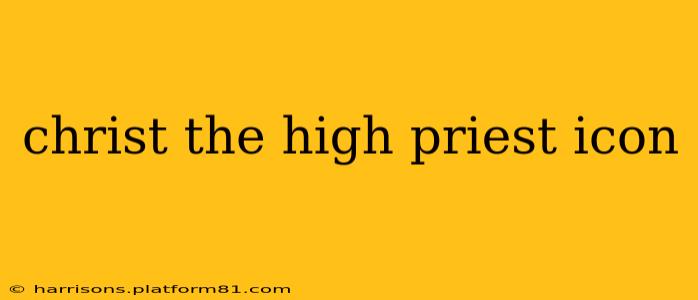The icon of Christ the High Priest is a powerful and deeply symbolic image within the Eastern Orthodox and Byzantine traditions. It depicts Jesus not merely as a king or judge, but as the ultimate High Priest, mediating between God and humanity. This portrayal carries profound theological implications and offers a rich visual language for understanding Christ's role in salvation. This article will explore the iconography, symbolism, and theological significance of this important image, answering common questions surrounding its representation and meaning.
What does the icon of Christ the High Priest symbolize?
The icon of Christ the High Priest typically portrays Jesus in priestly vestments, often including a richly embroidered omophorion (a shoulder cloth), sometimes holding a chalice or paten (the liturgical vessels used for communion). The symbolism is multi-layered. The vestments themselves represent His role as the perfect High Priest, fulfilling and surpassing the Old Testament priesthood. The chalice and paten directly reference the Eucharist, the ultimate sacrifice and offering made for the salvation of humanity. The overall message is one of sacrifice, intercession, and the ultimate union between God and humankind achieved through Christ's priestly ministry.
What are the key features of Christ the High Priest iconography?
Several key features consistently appear in depictions of Christ the High Priest:
- Priestly Vestments: These are crucial, clearly indicating His priestly office. The detail and richness of these vestments vary depending on the artistic style and the specific iconographer's interpretation, but their presence is essential.
- The Omophorion: This shoulder cloth often features intricate embroidery and is a powerful symbol of Christ's shepherding role and His covering of the people's sins.
- The Chalice and Paten: These vessels represent the Eucharist, symbolizing Christ's sacrifice and His continual presence amongst His people. They emphasize the ongoing nature of His priestly work.
- Facial Expression: The depiction often shows Christ with a compassionate and merciful gaze, reflecting His loving intercession for humanity before God.
- Gestural Language: Sometimes, Christ's pose or hand gestures might further emphasize His role as intercessor, offering or blessing.
How is the icon of Christ the High Priest different from other Christological icons?
Unlike icons depicting Christ as King, Judge, or Pantocrator (Almighty), the High Priest icon focuses specifically on His role as mediator between God and humankind. Other icons emphasize His authority or majesty, while the High Priest icon highlights His compassionate service and sacrificial love. This subtle but significant difference shapes the viewer's understanding of Christ’s multifaceted nature.
What is the theological significance of the Christ the High Priest icon?
The theological significance rests on the understanding of Christ fulfilling the Old Testament prophecies concerning the High Priest. He transcends the limitations of the Levitical priesthood, offering a perfect and eternal sacrifice. Through His death and resurrection, He becomes the ultimate mediator, reconciling humanity to God. The icon serves as a visual reminder of this profound act of atonement and the enduring nature of His priestly ministry.
Where can I find examples of Christ the High Priest icons?
While widely dispersed across Orthodox and Byzantine traditions, you can find excellent examples in various museums, churches, and private collections dedicated to religious art. Online image searches focusing on “Christ the High Priest icon” can also yield numerous examples showing the stylistic variations across different eras and regions.
What is the significance of the color palette in Christ the High Priest icons?
The color palette employed in these icons often reflects traditional symbolic meanings within Byzantine art. Gold, for example, frequently symbolizes divinity and the heavenly realm, while richer colors in the vestments may indicate His glory and the richness of His sacrifice. The choice of colors further enhances the overall symbolic impact of the image.
This exploration of the Christ the High Priest icon hopefully illuminates its rich symbolism and enduring theological significance. As a visual representation of Christ's mediating role, this icon serves as a powerful reminder of His selfless love and ultimate sacrifice for humanity. Its continuing presence in Orthodox worship underscores its deep and lasting importance.
